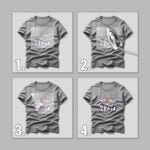Heat transfer vinyl, or HTV, is a type of film used to print custom designs, lettering, and numbers onto different fabrics. It is commonly used to create sports kits, party wear, and apparel for private businesses. Additionally, printable HTV is easy to print onto, cut, and press.
Iron-on films are generally available as cuts from a larger roll or in small rolls. Vinyl pressing, which is excellent for producing unique promotional clothing and designs, features an adhesive backing. This adhesive backing allows for easy cutting and weeding in preparation for heat transfer.
Moreover, you can use vinyl material with specialist printing and cutting machines, and you can press and print using a household iron or a heat press. Popular cutting machines include the Cricut Maker, Cricut Joy, Cricut Explore, Brother ScanNCut, Silhouette Cameo, and Silhouette Portrait.
HTV has a glossy side, known as the carrier sheet, which covers the vinyl itself. The other side, which is matte, is the cuttable, adhesive side. It is important to remember this distinction when cutting out your design. Please note that there may be some exceptions to this general rule.






